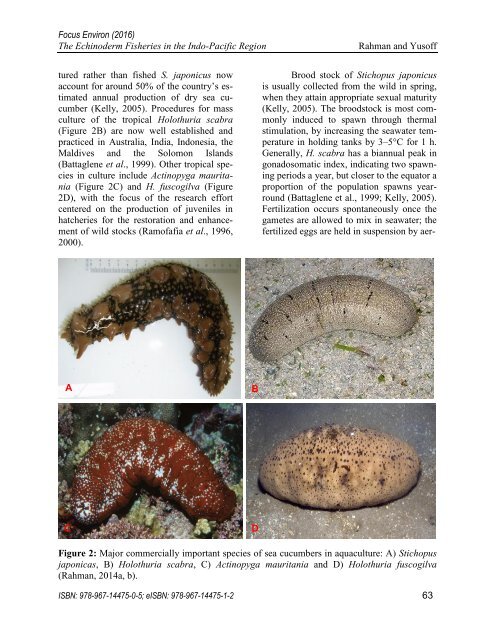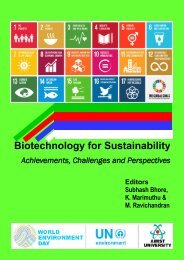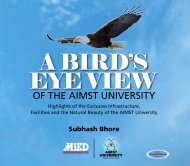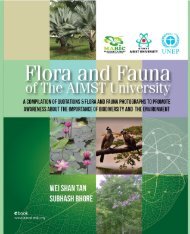Focus on Environment
This book is the Proceedings of the ‘National Seminar on Sustainable Environment and Health 2016’ & ‘World Environment Day-2016 (WED-2016)’ events held on the campus of AIMST University, Kedah, Malaysia. ISBN: 978-967-14475-0-5 (Print version); eISBN: 978-967-14475-1-2 (e-Book version) Editors Subhash Bhore & K. Marimuthu
This book is the Proceedings of the ‘National Seminar on Sustainable Environment and Health 2016’ & ‘World Environment Day-2016 (WED-2016)’ events held on the campus of AIMST University, Kedah, Malaysia.
ISBN: 978-967-14475-0-5 (Print version); eISBN: 978-967-14475-1-2 (e-Book version)
Editors
Subhash Bhore & K. Marimuthu
You also want an ePaper? Increase the reach of your titles
YUMPU automatically turns print PDFs into web optimized ePapers that Google loves.
<str<strong>on</strong>g>Focus</str<strong>on</strong>g> Envir<strong>on</strong> (2016)<br />
The Echinoderm Fisheries in the Indo-Pacific Regi<strong>on</strong><br />
Rahman and Yusoff<br />
tured rather than fished S. jap<strong>on</strong>icus now<br />
account for around 50% of the country’s estimated<br />
annual producti<strong>on</strong> of dry sea cucumber<br />
(Kelly, 2005). Procedures for mass<br />
culture of the tropical Holothuria scabra<br />
(Figure 2B) are now well established and<br />
practiced in Australia, India, Ind<strong>on</strong>esia, the<br />
Maldives and the Solom<strong>on</strong> Islands<br />
(Battaglene et al., 1999). Other tropical species<br />
in culture include Actinopyga mauritania<br />
(Figure 2C) and H. fuscogilva (Figure<br />
2D), with the focus of the research effort<br />
centered <strong>on</strong> the producti<strong>on</strong> of juveniles in<br />
hatcheries for the restorati<strong>on</strong> and enhancement<br />
of wild stocks (Ramofafia et al., 1996,<br />
2000).<br />
Brood stock of Stichopus jap<strong>on</strong>icus<br />
is usually collected from the wild in spring,<br />
when they attain appropriate sexual maturity<br />
(Kelly, 2005). The broodstock is most comm<strong>on</strong>ly<br />
induced to spawn through thermal<br />
stimulati<strong>on</strong>, by increasing the seawater temperature<br />
in holding tanks by 3–5°C for 1 h.<br />
Generally, H. scabra has a biannual peak in<br />
g<strong>on</strong>adosomatic index, indicating two spawning<br />
periods a year, but closer to the equator a<br />
proporti<strong>on</strong> of the populati<strong>on</strong> spawns yearround<br />
(Battaglene et al., 1999; Kelly, 2005).<br />
Fertilizati<strong>on</strong> occurs sp<strong>on</strong>taneously <strong>on</strong>ce the<br />
gametes are allowed to mix in seawater; the<br />
fertilized eggs are held in suspensi<strong>on</strong> by aer-<br />
A<br />
B<br />
C<br />
D<br />
Figure 2: Major commercially important species of sea cucumbers in aquaculture: A) Stichopus<br />
jap<strong>on</strong>icas, B) Holothuria scabra, C) Actinopyga mauritania and D) Holothuria fuscogilva<br />
(Rahman, 2014a, b).<br />
ISBN: 978-967-14475-0-5; eISBN: 978-967-14475-1-2 63







